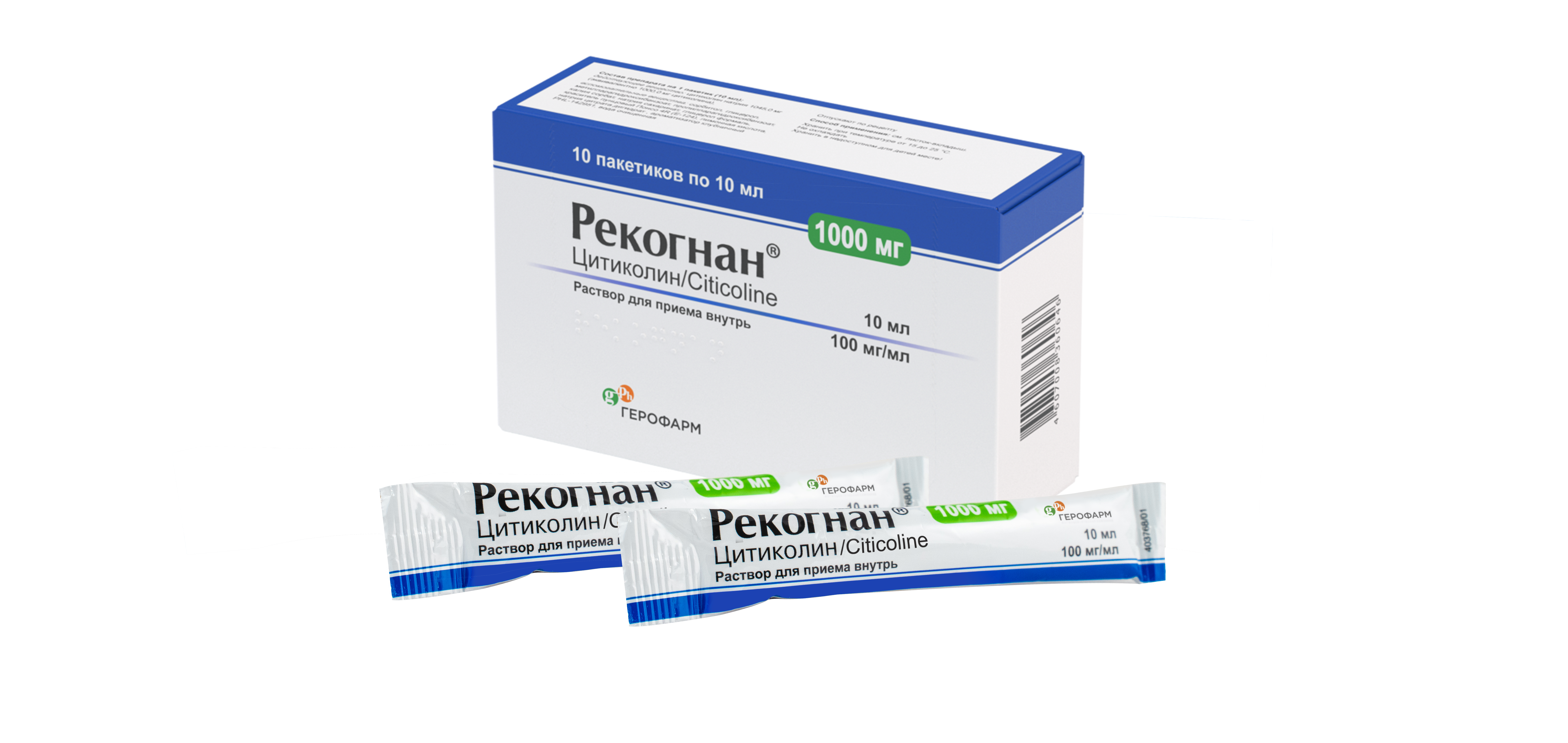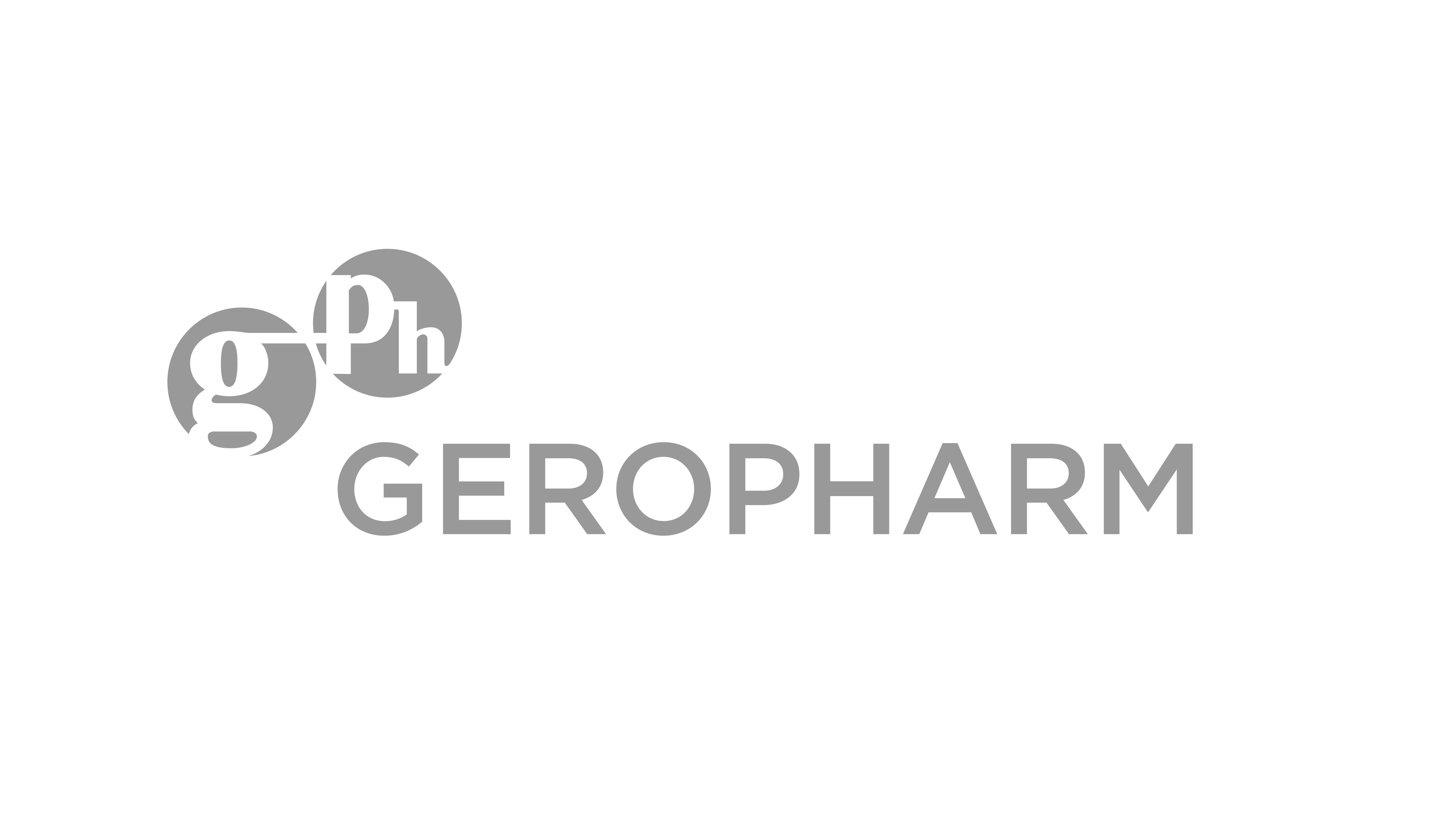Recognan® is a novel neuroprotector (INN: citicoline) with a wide spectrum of therapeutic possibilities. Thus, it is used to treat ischemic insult both in the acute and recovery periods, acute and recovery periods of craniocerebral trauma, cognitive and behavioral disturbances in degenerative and vascular disorders of the brain.
Citicoline is a precursor to phosphatidylcholine which is one of basic components of cellular membranes. According to the research, citicoline does not only promotes healthy function of neuronal membranes but also leads to a higher density of dopamine and acetylcholine receptors. That’s why Recognan® is used not only as an agent for treatment of various diseases and conditions but also as a drug that improves mental and cognitive functions.
Recognan® is the best known physiological neuroprotector. This substance is a natural chemical in the body, thus, being the first choice drug for treatment, prevention and improvement of nervous system functional activity. It is included into the list of VED and federal standards of specialized medical aid.
Recognan® is issued in different dosage forms: ampoules containing solution for i/v and i/m infusion, vials and packs containing oral solution. This improves marketability of the product considerably. The agent is produced at a modern industrial site of a group of companies (GEROPHARM-Bio facility). High-quality Japanese substance is utilized during the manufacturing process.
Patients get a real possibility to preserve and support high quality of life with therapy of maximum convenience due to effectiveness of the novel neuroprotector in therapy of strokes, CCT and its consequences and once daily regimen.
This drug is a prescribed medicine. It can be dispensed on a doctor's prescription only. There are contraindications. Please read the patient information leaflet. Do not use the medicinal agent if it was not prescribed by your treating physician. Always follow the patient information leaflet and your doctor’s recommendations.
Citicoline is an active substance of Recognan.
Citicoline is a trimethylated nitrogenous base. It is composed of a mononucleotide comprising ribose, pyrophosphate, cytosine, and choline participating in two important pathways of metabolism:
- synthesis of phospholipids;
- synthesis of acetylcholine.
When taken by mouth and in i/m and i/v administration, citicoline is rapidly absorbed. The byproducts of exogenous citicoline formed by hydrolysis in the intestinal wall and liver are choline and cytidine. Following absorption, choline and cytidine enter systemic circulation, cross the blood-brain barrier for re-synthesis into citicoline in the brain.
Resynthesized citicoline promotes the following processes in the brain:
Neuronal membrane reparation
Exogenous citicoline rapidly repairs the damaged surface of the cell and mitochondrial membranes and ensures integrity and bioenergy potential of the cell. Citicoline inhibits the action of phospholipases, preventing cell death.
Synthesis of cell membrane phospholipids
In ischemia, there is a great demand in accelerated synthesis of phospholipids associated with the need to support neurogenesis processes, axon sprouting and synaptogenesis. When exogenous citicoline is introduced into the body, it accelerates synthesis of phospholipids and neuronal reparation.
Neurotransmitter reproduction (cholinergic and dopaminergic)
Citicoline is a choline donor involved in the biosynthesis of acetylcholine Citicoline increases release of acetylcholine in cholinergic nerve endings and improves attention, memory and education measures.
Citicoline also increases synthesized dopamine due to increased activity of tyrosine hydroxylase inhibiting dopamine reuptake.
Decreased accumulation of free fatty acid (antioxidant effect)
Deficit of cellular energy and depleted ATF in neurons of ischemic tissues result in disintegration of membrane-contained phosphatidylcholine with free acid formation. These compounds protect the adjacent areas from ischemia. In the result of exchange processes, free fatty acids produce toxic metabolites and free radicals by blocking mitochondrial oxidative phosphorylation.
Citicoline inhibits the release of free fatty acids.
International Non-proprietary Name: citicoline
Dosage forms:
- solution for i/v and i/m infusion;
- oral solution.
Composition:
- one vial 500 mg/4 ml contains 522.5 mg of a monosodium salt of citicoline as an active substance (equivalent to 500 mg of citicoline);
- one vial 1,000 mg/4 ml contains 1,045.0 mg of a monosodium salt of citicoline (equivalent to 1000 mg of citicoline);
- 100 ml of oral solution contain 10.45 mg of a monosodium salt of citicoline (equivalent to 10.00 mg of citicoline).
Description:
- solution for i/v and i/m infusion: transparent colorless fluid;
- oral solution: transparent oral fluid with characteristic strawberry flavor.
Pharmacotherapeutic group:
nootropic agent.
ATC code: N06BX06.
Pharmacodynamics:
citicoline restores damaged cellular membranes, inhibits the action of phospholipases, prevents excessive accumulation of free radicals and cellular death by acting on the mechanisms of apoptosis. It decreases the damage of brain tissue in acute stroke. In craniocerebral trauma, it reduces the length of posttraumatic coma and intensity of neurological symptoms and decreases the recovery period duration.
Citicoline is effective in treatment of cognitive, sensitive, motor neurological disturbances of degenerative and vascular origin.
In chronic cerebral ischemia, it is effective in treatment of memory impairment, lack of initiative, difficulty doing everyday activities and self-care. It improves attention and consciousness decreasing manifestations of amnesia.
Indications for use:
- acute period of ischemic stroke (as part of complex therapy);
- recovery period of ischemic and hemorrhagic strokes;
- craniocerebral trauma (CCT), acute (as part of complex therapy) and recovery periods;
- cognitive and behavioral disturbances in degenerative and vascular disorders of the brain.
Contraindications:
it must not be given to patients with vagotonia or hypersensitivity to any component of the drug.
It is not recommended to use the agent in children under 18 years of age due to the lack of sufficient clinical data.
Rare inherited diseases associated with fructose intolerance for oral solution.
Use in pregnancy and breastfeeding:
there is no sufficient data that the agent is effective for use in pregnancy.
Recognan® is indicated during pregnancy only when benefit for a mother outweighs potential risk for a fetus.
Women must not take Recognan® during breastfeeding, as there are no data on the excretion of this drug into breast milk.
Directions for use and dosage:
solution for i/v and i/m infusion is given intravenously and intramuscularly.
It is administered via veins in the form of intravenous infusion (during 3–5 minutes) or drip feeding (40–60 drops per min).
Intravenous route of administration is more preferable than intramuscular one. During intramuscular administration, multiple infusion at the same place must be avoided.
Recommended dosage regimen:
Acute period of ischemic stroke and CCT:
1,000 mg every 12 hours from the first days of diagnosis. Duration: at least 6 weeks. In 3–5 days after the treatment was initiated, switch to peroral preparations is possible.
Recovery after ischemic and hemorrhagic strokes, recovery after CCT, cognitive and behavioral disturbances in degenerative and vascular diseases of the brain:
500–2,000 mg per day. Dosage and treatment course depend on the symptom severity: use of peroral agents is possible.
Oral solution:
it is given by mouth. Prior to use, it can be diluted in a small glass of water (120 ml or ½ of glass). It is taken with or between food.
Recommended dosage regimen:
500–2,000 mg per day (5–10 ml 1–2 times a day or 1 pack (1,000 mg) 1–2 times a day). Dosage and treatment course depend on the disease severity.
Elderly patients:
no dose adjustment is required.
Side effect:
very rare (less than 1/10,000): allergic reactions, headache, dizziness, hot flashes, tremor, vomiting, diarrhea, hallucinations, edema, dyspnea, insomnia, decreased appetites, numbness in paralyzed limbs, change in hepatic enzyme activity. In some cases it can stimulate the parasympathetic system and produce a short-term effect on the arterial pressure level.
If any of the mentioned side effects are getting worse or if any other not mentioned side effects occur, consult a physician.
Overdose:
no overdose cases are described.
Interaction with other medicinal agents:
citilicone increases the therapeutic effect of levodopa.
It must be given concomitantly with other meclofenoxate-containing agents.
Special warnings:
effects on ability to drive and use machines:
During treatment performing potentially dangerous types of activity that require increased attention and fast psychomotor reactions must be done with caution.
Oral solution:
some amount of crystals can be formed in the cold due to temporary partial crystallization of preservatives. Crystals do not affect the drug’s quality.
Form of presentation:
intravenous and intramuscular solution, 500 mg/4 ml, 1,000 mg/4 ml.
By 4.0 ml in colorless glass ampoules of neutral glass with a band for breaking ampoules; 5 ampoules per contoured cellular pack. One or two contoured packs with instructions for use are placed in a box.
Oral solution, 100 mg/ml
Vial. By 30 ml in transparent glass tamper-evident vials capped with white polypropylene stoppers. Vials supplied with a pipette and package insert placed in carton box.
Packs. By 10 ml in packs made of multi-layered composite material, 5 or 10 packs with package insert placed in carton box.
Storage conditions:
store
vials and packs at 15–25 °C.
Ampoules 1,000 mg and 500 mg at 2–25 °C.
Keep out of reach of children.
Shelf-life:
ampoules and vials for 3 years.
Packs for 2 years.
Dispensing conditions:
by prescription.
The firm accepting claims:
GEROPHARM LTD, Russia
B-11, Degtyarny per., Saint Petersburg, 191144
Phone: (812) 703-79-75 (MLT)
Fax: (812) 703-79-76
toll-free number: 8-800-333-4376 (free call across the Russian Federation)
www.geropharm.ru
Please read the patient information leaflet for detailed information on the drug.
Recognan® (INN citicoline) is a nootropic agent, precursor of key ultrastructural components of a cellular membrane. It is available in different forms for injected and oral administration.
Injected forms are presented as solutions for intramuscular and intravenous administration (ampoules 500 mg/4 ml and 1,000 mg/4 ml). Ampouled solution is intended for single use. It must be used immediately after opening. Injectable preparations are compatible with all types of intravenous isotonic solutions and dextrose solutions.
Peroral form is presented as an oral solution 100 mg/ml in 30 ml vials and 10 ml packs (5 or 10 packs per box). Oral solution is taken with or between food. Prior to use, it can be diluted in a some water (120 ml or ½ of glass). Bioavailability of oral citicoline solution is equivalent to that after intravenous administration.
High-quality substance produced in Japan was used during manufacture of Recognan®.



